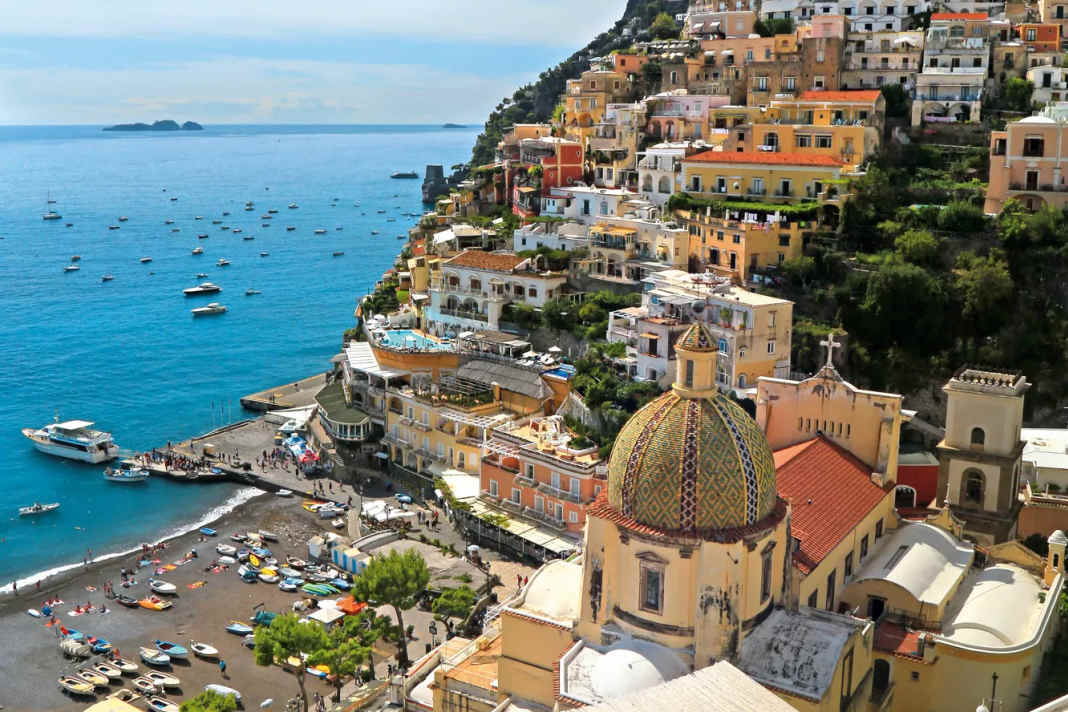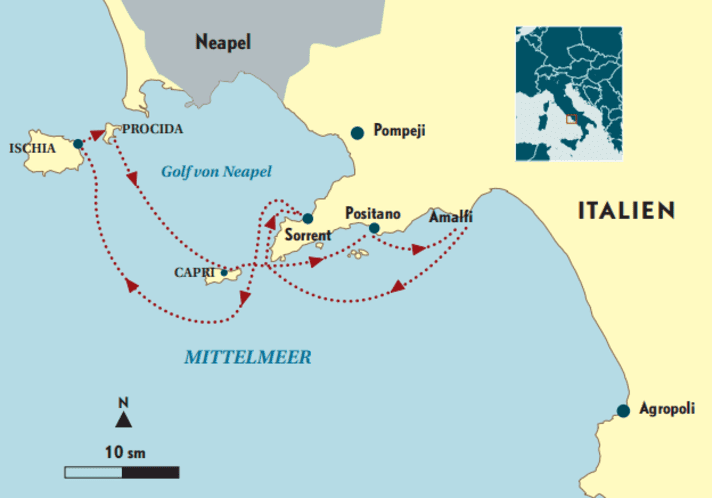





Crews will find much of what makes sailing in Italy so attractive around the Sorrento Peninsula and the Gulf of Naples: a spectacular, mountainous landscape with picturesque villages on the slopes, the two legendary islands of Capri and Ischia, plus excellent cuisine. The short distances between the destinations are ideal for those who want to see and experience a lot instead of clocking up the miles. This is difficult anyway due to the often mild winds in the area.
The region is equally popular with land-based holidaymakers and sailors, the towns are bustling, it gets crowded in July and August and the price level is high. This should be taken into account when planning your trip.

Day 1: Procida-Capri (16/19 nm)
The most beautiful starting harbour is on the small island of Procida. The transfer from Naples by taxi and ferry is short. Alternatively, you can leave from Salerno, but it is a very long journey to get there. On the first day, be sure to sail eastwards around Procida to Corricella and anchor in the bay for a swim. You can also take the dinghy across and explore the pretty town. Then on to Capri. The marina is one of the most expensive in Italy and very busy, so be sure to book in advance (www.portoturisticodicapri.com)! The climb to the town at the top of the mountain with its magnificent view of the sea is well worth the investment. If you don't get a place, sail around the island to the south side to the anchorage at Marina Piccola or moor at a mooring buoy there.
Day 2: Capri-Positano (13 nm)
Positano, with its brightly coloured houses, is picturesquely situated in a crevice and on two rocky ridges. The beach is a hive of summer activity with good bars, restaurants and ice cream parlours. Unfortunately, anchoring in front of the village is prohibited; you have to moor in the buoy field. This is expensive in summer at 100 euros per night. It is a little cheaper in the early and late season. A free taxi boat takes you to the shore.
Day 3: Positano-Amalfi (7 nm)
Just a stone's throw along the spectacular coast. You can hardly get enough of the steep mountains with the small villages clinging to the rocks. The approach to the harbour is narrow, which is why harbour master Giulio comes to meet the charter yacht with the dinghy, climbs on board and wants to take over the mooring manoeuvre. This is unusual, but the man is trustworthy. The night in the harbour costs almost 120 euros for a 40-foot boat - that's a lot. But the town is simply magnificent: surrounded by steep mountain slopes, criss-crossed by winding alleyways and centred on the large square in front of the cathedral. The shops sell buffalo mozzarella from Campania, lemons from Amalfi and the most delicious pastries. By the way, if you can't get a place on the boat in Amalfi, simply sail a few miles further to Cetara. The village is a smaller and much quieter version of Amalfi.
Day 4: Amalfi-Sorrento (20 nm)
A long drive around Cape Sorrento. The town itself lies high up on a plateau. You should try the lemon liqueur Limoncello here at the latest.
Day 5: Sorrento-Ischia (18 nm)
Another, longer trip across the Bay of Naples to the island. The harbour in the main town is noisy and full of ferries. It's better to go a mile further west to the marina in the pretty town of Casamicciola. From there, take a taxi to the centre.
Day 6: Ischia-Procida (6 nm)
It is worth sailing a little further along the coast of Ischia or anchoring at the foot of the Aragonese castle on the eastern tip to go for a swim. Then back to the charter base. If you didn't stop at Corricella at the beginning, you can still do so now.
Territory character Gulf of Naples
The small-scale area south of Naples and around the headland of Amalfi is ideal for relaxed short-distance trips. As beautiful as the offshore islands and harbour towns on the mainland are, there are unfortunately only a few good marinas. Anchor bays are also rare. However, there are good mooring buoy fields in some places. Or you can get a place in one of the small municipal harbours, which only offer a mediocre service. Mooring fees are also high, especially in summer. Over 100 euros is almost the norm for a 38-foot boat. Ideally, you should explore the area in the early and late season, i.e. in May and June or in September.
Wind &Weather
The Gulf of Naples and the Amalfi Coast are considered a light wind area. During the summer, the Tramontana dominates from the north-west. Thermal effects, downdrafts and jets below or along the steep coast should be taken into account. At Libeccio and Scirocco, the wind shifts to the south-west and south respectively. In summer it is often hot with light winds, and in the marginal seasons there are sometimes disturbances from the west. These are sometimes accompanied by strong thunderstorms.

